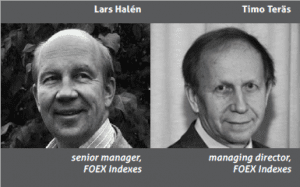By FOEX Indexes’ Lars Halén and Timo Teräs
NBSK pulp Europe
The pulp market in Europe is slowing down in the seasonally quieter period of the year. In addition to the usual weakening interest to transact with pulp, the lower softwood pulp demand in China is affecting the BSKP markets elsewhere in the world. As a positive note, the emerging hopes, although still not finally approved, for a continued support for Greece and reduced fears for a Grexit, could start creating a more positive environment also to pulp markets. The fundamentals in BSK are supported by the continued shrinking of the price differential to BHK pulps which, when comparing the PIX index values, was down in early July to below 50 USD per ton, about one-fourth of the average during Q3 last year.
Our PIX NBSK index in dollars moved this time again slightly down as it retreated by 0.13 USD/ton, or by 0.02%, and closed at 851.16 USD/ton. US dollar appreciated against the Euro by 0.7% (weekly average). Due to the weakening of the Euro against the US dollar, the benchmark value in euro headed north by 5.22 euro, or by 0.68%, and the PIX NBSK index value in euro ended at 770.98 EUR/ton.

BHK pulp Europe
In BHKP, the demand pull remained strong in June and it seemed to continue similarly when going into July. However, the long predicted negative impact of the new tonnage from the Guaiba mill might have only moved forward due to the difficulties in the start-up and several production stops during the first two months of the pulp line’s history. Since early July the new line is back in production and is on track to reach the targeted volume of 500 000 tons this year.
The healthy hardwood pulp statistics seen for April are likely to have continued reasonably well also in May-June, based on the BHKP index development which has shown an increase of USD 10-15 per ton each month during the second quarter. The new pulp statistics over June are expected to include again hardwood, too, and are therefore waited for with keen interest.
Our BHKP benchmark moved up this time by 0.65 USD/ton, or by 0.08%, and closed at 800.25 USD/ton. Last week, the value of Euro depreciated by 0.7% against the US dollar (weekly average). When converting the USD-value into the weakened Euro, the PIX BHKP index in Euro moved up by 5.60 euro, or by 0.78%, and closed at 724.86 EUR/ton.
Paper industry
The seasonally slow part of the year has started. During July-August, shipments of pulp and paper go down. In pulp, July is typically the weakest month as buyers in the paper industry segment do not want deliveries just prior to their holidays and downtime period. In paper and board, August is the slowest month. Consumers on holiday have their needs down, buyers in printing and related industries are not active and the peak demand for packaging by the large agricultural sector only comes in September. On the other hand, weather conditions are typically favourable for the production process and especially in pulp, but also in paper, Q3 production tonnage tends to exceed to shipment volumes. This means rising inventory levels at/near the producers.
Several paper price increase initiatives are on, mostly from July 1. Due to the seasonal factors mentioned above, this is not the ideal time for trying to raise prices. On the other hand, there are many factors supporting these paper industry initiatives. The main one is, obviously, the decreases in prices seen over the past 1-2 years and the insufficient profitability. The weakening of the Euro is another, as the price of pulp is up in Euro-terms. Recently, also the recovered paper prices have been on a rise. Finally, the countervailing duties and other efforts to protect the domestic producers help prices higher, at least in theory. In practice, the downside pressures move from one region to another. The level of success, if any, of the price increase efforts will start becoming visible in late July/early August.
[box]
FOEX Indexes Ltd produces audited and trade-mark registered PIX price indices for certain pulp, paper packaging board, recovered paper and wood based bioenergy/biomass grades. The PIX price indices serve the market in a number of ways. They function as independent market reference prices, showing the price trend of the products in question. FOEX sells the right to banks and financial institutions to use the PIX indices for commercial purposes, while RISI Inc. has the exclusive re-selling rights for subscriptions to the PIX data and market information. Please enquire for subscriptions at [email protected] or via the following link www.foex.fi/subscribe/.
Tissue papers are produced either from virgin fibre, recovered fibre and various mixes of both, depending on the end product. High quality hygiene tissue products like medical tissue products, facial tissues, table napkins or other such household and sanitary products are often made exclusively or almost exclusively from virgin fibre pulp, whereas the share of recovered fibre typically increases in tissue products for a variety of end uses outside personal hygiene, such as kitchen towels or towels for garages or other such industrial production facilities etc. Providing PIX pulp price indices gives the paper producer and buyer insight in the price trends with a weekly frequency. PIX indices are used as market reference prices e.g.
– by banks or exchanges that offer price risk management services for pulp buyers and sellers
– by buyers and sellers of pulp or paper in their normal supply contracts
– companies who want to employ an independent market reference price for internal pricing (e.g. pulp mill – paper/paperboard mill, paperboard mill – box plant) through licensing the commercial use from FOEX.
In addition, our price indices are widely used in financial analysis, market research and other such needs by all kinds of parties linked directly or indirectly to forest product or wood-based bio-energy industries.
This way the companies have better tools to budget their cost or income structure and profitability, and may concentrate on their core businesses with less time spent on price negotiations, which tend to increase in these days as the planning span narrows in the wake of the short, quarterly business cycles and, nowadays, in most cases, monthly raw material pricing decisions.
Subscription – For access to the latest PIX Pulp and Paper index values and commentary, please subscribe to the “PIX Pulp and Paper Service” via the following link www.foex.fi/subscribe/
[/box]

























